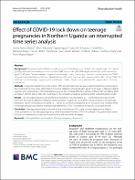| dc.description.abstract | Pregnancy and childbirth complications are the leading cause of death among girls aged 15–19 years globally, with low- and middle-income countries (LMICs) accounting for 99% of global maternal deaths of women aged 15–49 years. Despite teenage pregnancies declining in many developing countries in recent years, the COVID-19 period intensified the problem and altered the trend for most countries. We determined the effect of the COVID-19 lockdown on the teenage pregnancy trend in Pakwach district, Uganda, to understand its magnitude in our study population.
Using interrupted time series analysis (ITS), sometimes known as quasi-experimental time series analysis. We constructed a time series of the first ANC service utilization records for girls aged 10–19 years in Pakwach district, Uganda, and conducted an interrupted series analysis. We compared the two periods of March 2019 to March 2020 and March 2020 to March 2021. We used Stata 15 to conduct our analysis, performed OLS, and plotted the results.
The teenage pregnancy trend before the lockdown was decreasing by − 0.203 pregnancies per month, but in the first month after the institution of the lockdown (March 20, 2020), there was an increase in the teenage pregnancy rate of 13.9 pregnancies [95% CI: − 33.6 to 61.5], which corresponds to an increase in the monthly trend in teenage pregnancies (relative to the period before the COVID-19 lockdown trend) of 1.53 girls per month.
Teenage pregnancies increased during the lockdown. This slight increase depicted the impact of the pandemic on the teenage pregnancy trend associated with the COVID-19 outbreak. The government needs to focus on intervention to reduce this trend and avoid any further increases. | en_US |


